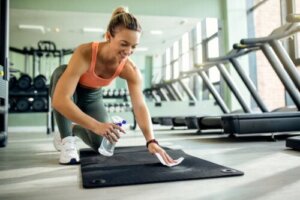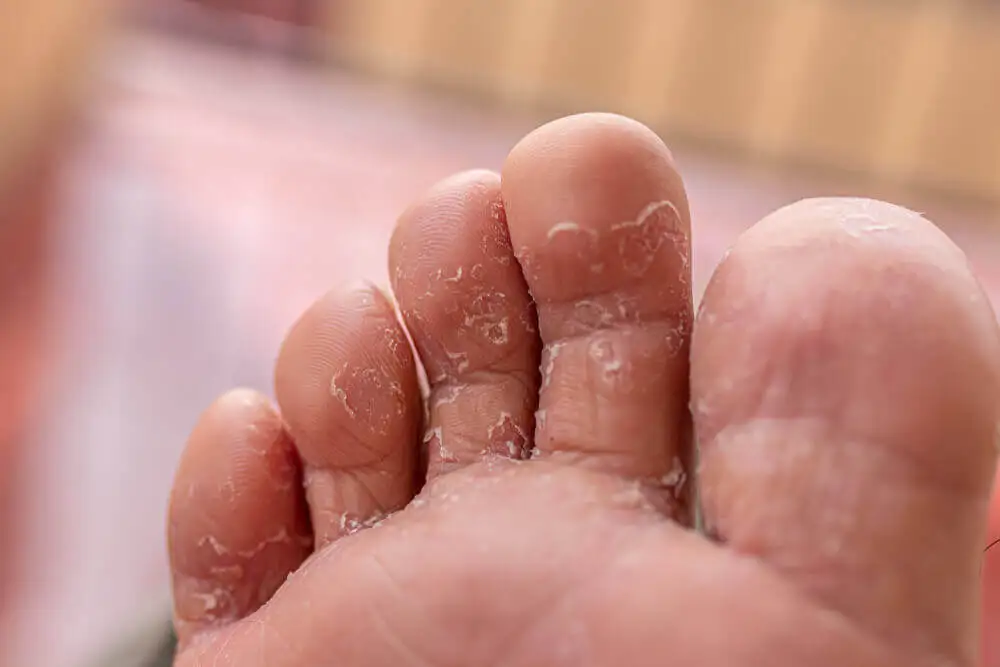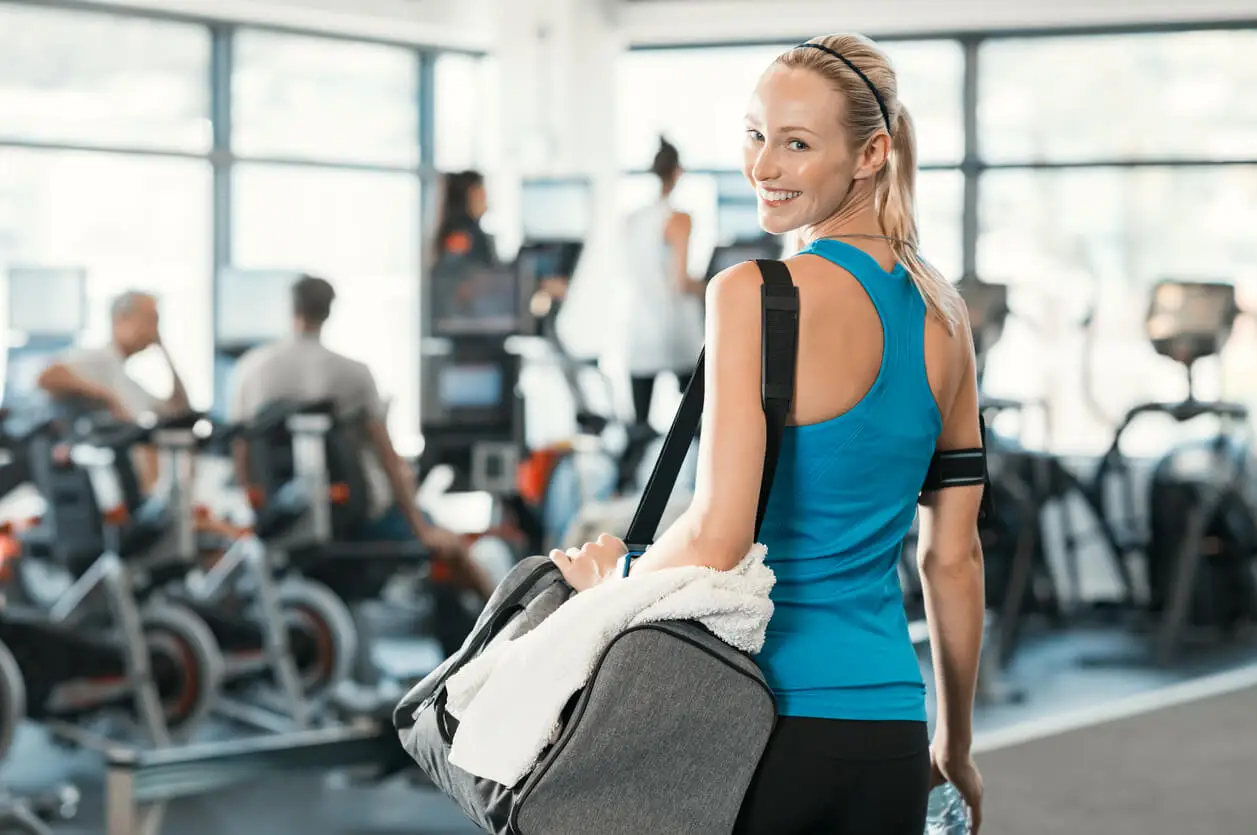Preventing Skin Infections at the Gym

Gyms and fitness centers are great places to exercise and keep fit. However, we must be cautious, because there are also potential risks of contracting skin infections at the gym.
The machines and exercise benches come into contact with people’s skin, leaving traces of sweat and other elements, which may contain fungi and bacteria.
Athlete’s foot, jock itch, impetigo, among others, are among the most common skin infections that are transmitted in gyms. Here we’ll see some measures that can be taken to prevent them without having to stop keeping fit!
Why do skin infections occur in the gym?
A gym is an enclosed space, where many people stay for prolonged periods of time. Different types of infections can be transmitted in such places. For example, a common cold when someone sneezes or coughs without covering their mouth.
However, skin infections in the gym are just as common, if not more so, than respiratory tract infections. This is because bacteria, fungi and other pathogens, along with sweat, are left on equipment, towels or in damp areas, such as saunas, showers and even hot tubs.
According to a 2014 study, different types of bacteria have been found on exercise machines, stair handrails and toilet handles in fitness centers.
Moreover, several factors contribute to the occurrence of skin infections in the gym:
- Roughness in contact sports (such as boxing or wrestling).
- The presence of open wounds.
- Using the same towels.
- Sharing implements and equipment.
- Walking barefoot in bathrooms or around swimming pools.
You may also be interested in: 7 Natural Remedies to Treat Fungi
Most common skin infections in gyms
There are several types of skin infections, which can be caused by fungi, bacteria, viruses or parasites. Here are the ones that are most easily transmitted in gyms.
Staphylococcal infection
Among the pathogens found in gym areas are bacteria of the group known as “staphylococcus”. We include those resistant to methicillin (MRSA), which can live on machines, exercise benches and mats for up to several days.
It’s estimated that a high number of people carry a variety of these bacteria. According to studies, MRSA has been identified as an emerging problem among athletes.
It’s a common source of skin infections, entering the body through wounds or cuts, which is why those who play contact sports are at increased risk of being affected.
This infection looks like a sting at first. It then turns into a blister that becomes red and inflamed, causing pain. It may also fill with pus.
The recommended treatment is with antibiotics. It’s important to note that if you experience the above symptoms, especially when there’s a fever, you should see a doctor soon to avoid sepsis.
Athlete’s foot
This skin disease is one of the most common in people who play sports. It is caused by a fungus that can be contracted by walking barefoot on wet floors (in areas such as bathrooms or swimming pools) or by wearing wet socks or shoes.
It’s characterized by a reddening of the skin between the toes, and flaking. Sometimes it can spread to other areas of the body.
Treatment is with antifungal agents. Although some home remedies are also commonly used to treat athlete’s foot.

Jock itch
Jock itch is caused by fungi that grow in moist environments. This includes sweaty clothing and wet towels. Symptoms are similar to an allergy and include redness, itching, scaling and blisters in the groin area.
It’s more common in men. It can also occur in other areas, such as the armpits. And in the case of women, under the breasts. Treatment is also with antifungals.
Folliculitis
Folliculitis is caused by a bacterium known as Pseudomonas aeruginosa. It can be found in hot tubs and swimming pools when chlorine levels are low.
This condition is also called bathtub folliculitis. According to research, it’s a common skin infection in people who go to swimming pools and saunas.
At first, it appears as red patches. Itching may occur and blisters may form in the follicles (papulopustular skin lesions). It often clears up without treatment, although, if symptoms persist, topical antibiotics are applied.
Impetigo
This is another infection caused by staphylococci or streptococci that can enter through a wound or insect bite. In certain cases, it also reproduces on healthy skin. It’s considered to be most prevalent in children.
This bacterium thrives in moist environments. And it can be transmitted by coming in contact with the skin of someone who has the infection or by using contaminated towels and sports equipment.
The infection initially appears as red, acne-like pimples. They fill with pus and then break, forming a brown crust. Treatment is with topical or oral antibiotics.
Plantar wart
This is caused by the human papillomavirus (HPV) that infects the skin. It’s associated with walking barefoot in common areas of gyms, such as showers or locker rooms.
Plantar warts appear as calloused patches that are rough to the touch. They may darken when blood is present from ruptured vessels. They’re also painful to walk on. Treatment includes topical use of salicylic acid.
If the warts persist, or are very painful, other procedures are applied, such as laser removal, nitrogen freezing and then removal.
Be sure to read: What’s the Best Food When Going to the Gym?
The best tips to prevent skin infections at the gym
Before, during, and after exercising there are different measures we should take to prevent skin infections at the gym. We’ll now tell you what they are.
1. Wash your hands
We must take into account that the equipment, weights or dumbbells have been touched by many people. And, although some people wear gloves, these are often the fingerless version.
The most important measure is to wash your hands before and after training, to avoid contagion and to avoid transmitting diseases.
If soap and water aren’t available, there’s the option of applying hand sanitizer gel or using wipes. With the latter, you can also clean the part of the equipment that comes into contact with your skin.
2. Take a shower
When you finish exercising, and especially after swimming in a pool, you should take a shower and change your sweaty clothes. We must use our own towels. Don’t use ordinary towels. And don’t forget to dry your feet well.
3. Wash your clothes
We must change the clothes we have used for training. You should never wear the same clothes again without having washed them, and, of course, use hot water.
In the case of swimming, swimsuits should be kept in a separate bag and washed separately, avoiding mixing them with other clothes or towels.
4. Use your own implements
Mats and gloves should be considered personal items. We shouldn’t lend them or use someone else’s.
You can also use a small mat to lie down on the exercise benches, avoiding direct contact with the skin.
5. Don’t go barefoot
Neither in the locker rooms nor in the showers should you go barefoot. It’s recommended to have flip-flops or sandals and only to use them for these purposes. They should be placed in a separate plastic bag when bringing them home.
6. Cover wounds
If you have recent wounds, it’s advisable to cover them with a bandage or dressing when we go to train. This is especially the case if we practice contact sports or if that part of the skin may come into contact with exercise equipment.
7. Have personal items
You shouldn’t share personal items, such as towels, razors, combs, hairbrushes or others that touch our skin.

The cleanliness of the gym
It isn’t our task to clean the place where we go to train, but it is important that we observe well how clean they are, to avoid contracting skin infections in the gym. In this sense, before registering, ask to take a look around the facilities.
It’s important to pay attention to details such as the following:
- The cleanliness of the bathrooms.
- If the equipment is rusty or if there are cracks in the cushioned areas.
- The existence of disinfectant wipes or sprays to clean equipment.
- If attendants pick up weights and equipment without wearing gloves or if they use the benches without placing a mat or matting.
Also, we can ask the gym assistants about cleaning routines (how often they are and what cleaning materials are used). We have every right to know because we’re paying customers and it’s our health that’s on the line.
All cited sources were thoroughly reviewed by our team to ensure their quality, reliability, currency, and validity. The bibliography of this article was considered reliable and of academic or scientific accuracy.
- Baptista Pereira L. Impetigo. Review. An. bras. dermatol. 2014; 89(2): https://doi.org/10.1590/abd1806-4841.20142283.
- Enright M, Robinson D, Randle G. The evolutionary history of methicillin-resistant Staphylococcus aureus (MRSA). PNAS. 2002; 99(11): 7687-7692. https://doi.org/10.1073/pnas.122108599.
- González-González A, Barrientos-García J, Sierra-Silva G. Frecuencia de tiña inguinal y su asociación con tiña de los pies, ungueal de pies o ambas. Dermatol Rev Mex. 2019; 63(4): 361-366.
- Lévano Vásquez J, García Sánchez-Montejo F, Campos Segovia A, Martínez-Villasante Alemán A, Arias Novas B. Foliculitis por Pseudomonas. Rev Pediatr Aten Primaria. 2016; 18(72): 355-357.
- Rihn J, Michaels M, Harner C. Community-Acquired Methicillin-Resistant Staphylococcus aureus: An Emerging Problem in the Athletic Population. The American Journal of sport medicine. 2005; 33(12): 1924-1929. https://doi.org/10.1177/0363546505283273.
- Stefani S, Chung D, Lindsay J. Meticillin-resistant Staphylococcus aureus (MRSA): global epidemiology and harmonisation of typing methods. International Journal of Antimicrobial Agents. 2012; 39(4): 273-282.
This text is provided for informational purposes only and does not replace consultation with a professional. If in doubt, consult your specialist.








